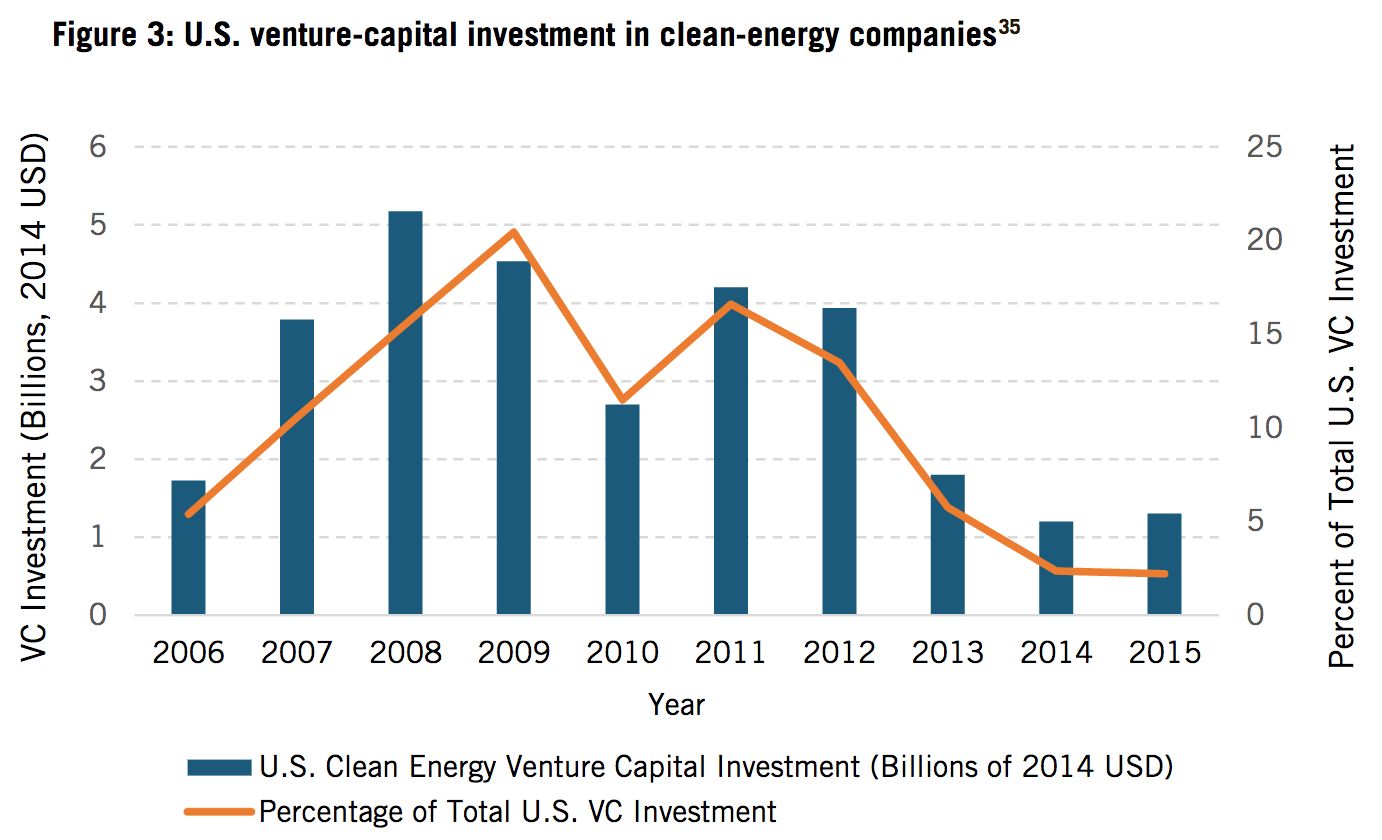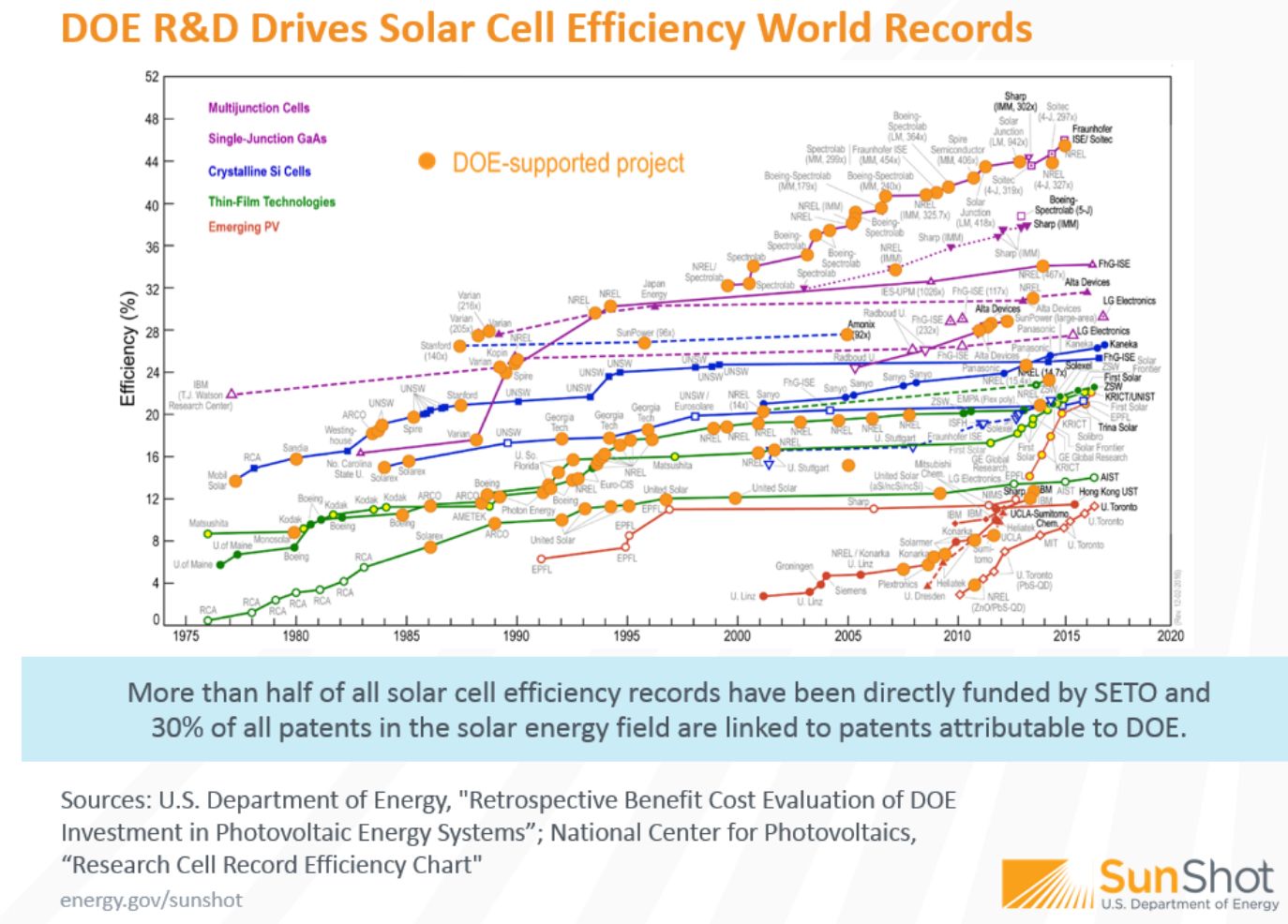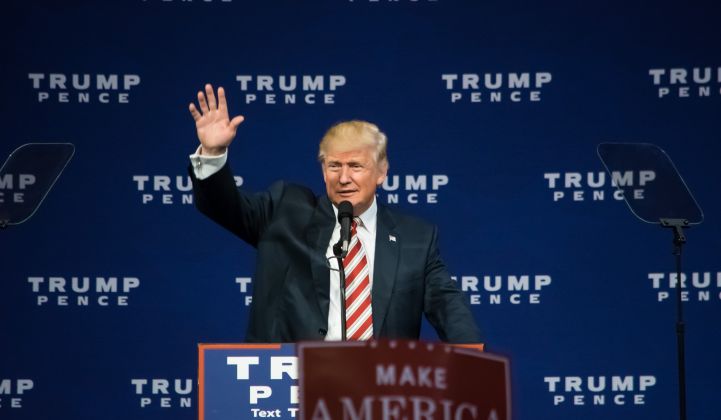The U.S. is losing the race on clean energy innovation, despite President Obama’s efforts to boost competitiveness in the sector.
According to a recent Bloomberg New Energy Finance study, China invested $287.5 billion in clean energy in 2016, while the U.S. spent $58.6 billion. Earlier this month, China’s energy agency announced a plan to spend more than $360 billion on renewable power sources like solar and wind through 2020.
As Donald Trump assumes the presidency, he has an opportunity to improve on President Obama’s clean energy legacy -- and possibly create thousands of jobs in the process. But it’s unclear if he sees this as an opportunity at all.
The word “innovation” came up numerous times during Trump’s transition into the White House. "We want you to keep going with the incredible innovation," the president-elect told Silicon Valley tech leaders, including Tesla CEO Elon Musk, at a meeting in December.
At the same meeting, Jeff Bezos, CEO of Amazon.com, said, “I’m super excited about the possibility that this could be the innovations administration.”
Bill Gates, who recently launched a $1 billion clean energy technology fund, said he emphasized there is “opportunity for innovation in not only energy, but also medicine and education,” at a recent meeting with Trump.
Earlier this month, several lawmakers participated in a panel discussion at the Consumer Electronics Show, where Republican speakers underscored their party’s commitment to “innovation policy.” At the event, Rep. Darrell Issa (R-Calif.) noted that Trump doesn’t have a strong personal interest in technology, but has made a point of surrounding himself with talented, tech-savvy people.
And when it comes to Trump’s pick to lead the Department of Energy, former Texas Governor Rick Perry, some supporters have said they believe innovation will be the hallmark of his tenure, if he is approved. In the past, Perry has said that energy innovation, including in the areas of energy storage and solar power, is one of “the most exciting” developments in the country. At his confirmation hearing this morning, Perry pledged support for DOE research and clean energy programs, although his comments were overshadowed by a budget cut proposal from Trump headquarters.
While it remains unclear what the Trump administration and new Republican-led Congress will ultimately prioritize, the messaging around invention and technology in the early days of the Trump transition may come as welcome sign to many in the clean energy sector. Could the new government’s interest in growing businesses and creating jobs be a boon for clean energy after all?
Asian countries out-invest the U.S.
A recent paper released by the Information Technology & Innovation Foundation (ITIF) argues that next-generation energy technologies are fueling economic growth at home and expanding exports abroad. However, the U.S. is falling behind in the race to capitalize on the burgeoning clean energy market.
According to the paper, 11 other countries around the world spend more on energy R&D as a percentage of GDP than does the United States. China spends three times as much.
Private investments in energy innovation have been weak as well. Venture capital and private equity investment in American renewable-energy companies, for instance, peaked in 2008 at $5.4 billion and dropped to $2.2 billion in 2015. Just a handful of U.S. companies have raised enough private capital to develop advanced nuclear reactors and carbon-capture technologies, while China offers strong support on all of these technology fronts.

Source: ITIF
A separate study from Bloomberg New Energy Finance found the overall cleantech investment gap to be even more dramatic. China spent $287.5 billion on clean energy in 2016, while the U.S. spent $58.6 billion.
“The United States is losing this race because Asian countries are out-investing the United States and dictating the terms of competition, often flooding the market with low-cost, unimaginative products,” the ITIF report states.
For the U.S. to regain its leadership position, ITIF calls on Trump and the 115th Congress to “make energy innovation a high priority and address the obstacles to developing and deploying new technologies.” The paper goes on to list how this could be achieved, with a particular focus on changes at the Department of Energy.
But does Trump’s view of innovation include making these types of reforms?
“In the four years since he was elected in 2012, I would say Obama viewed his legacy as climate and clean energy,” said former Colorado Gov. Bill Ritter, speaking at the National Association of Regulatory Utility Commissioners (NARUC) annual meeting last fall. “We will not see...a continuation of the Obama legacy. Then the question becomes, how much is it a reversal as opposed to some kind of a course correction?”
How to make the DOE more effective
The Trump transition got off to a rocky start at the DOE with the circulation of a controversial 74-question survey. The questionnaire hinted at the priorities of Trump’s energy transition team, which is led by Thomas Pyle, who runs the Institute for Energy Research and the American Energy Alliance -- both of which are primarily funded by fossil-fuel interests.
Several questions asked for information about the status of the DOE’s loan program; there was a question about technologies or products that have emerged from DOE programs that are commercially available without any subsidy; and there was a question about how the U.S. can optimize its advanced nuclear reactor research and development activities. These and other inquiries suggest the Trump administration will reform the DOE’s investments in emerging clean technologies, including electric vehicles and renewables.
According to sources familiar with the matter, the first transition meeting at the DOE’s Office of Energy Efficiency and Renewables focused on three topics: consumer choice, the proper role of the government, and how the DOE determines what to work on. It’s unclear what will emerge from those discussions following this weekend’s inauguration.
Changes at the DOE are significant for the overall clean energy industry because the barriers to market entry are so high, said David Hart, a senior fellow at ITIF. New technologies often have to compete with commodity providers, which means they have to hit stringent price targets. They also have to prove they’re highly reliable, which means the innovation process can take a long time.
The DOE has played a key role in both the early-stage development and commercialization phases of today’s clean energy technologies. For instance, more than half of all solar cell efficiency records have been directly funded by the DOE’s SunShot Initiative. Furthermore, SunShot’s incubator program supported 112 companies with $158 million, and those companies went on to raise more than $3.4 billion from separate sources -- a $22 return for $1 in public investment.
But DOE’s work could still be better.

“The DOE isn’t as effective as it could be at playing these various roles, but the Obama administration tried things that were creative, and I think the objective should be to build on those efforts...and expand the level of investment,” said Hart.
One mission the Trump administration could take on is to reorient the national laboratories to pursue commercially relevant RD&D. According to ITIF, that requires setting up “lab-to-market” programs to turn research results into practical applications. It also requires giving labs more autonomy. To facilitate that, the next Energy Secretary should increase the scale of Laboratory-Directed Research and Development (LDRD) funding from 4 percent to 6 percent of total lab spending.
Hart said that ARPA-E, which enjoys bipartisan support, should also be maintained and expanded. The Trump administration should also do more to encourage private investment in energy innovation. Venture capital investment has receded, while corporate expenditure on both in-house and external R&D has stagnated. “A priority for the new Congress and administration should be to reverse these trends,” according to the ITIF report.
The Trump administration can also improve on programs that floundered under Obama. According to Hart, the DOE didn’t do enough technology demonstrations during Obama’s tenure, particularly with respect for nuclear and carbon-capture technologies. Those technologies were likely neglected because they are particularly rife with challenges, Hart said -- “But I don’t think we can give up on them.”
It could also continue matching supply push policies with demand pull policies, to bring more technology into the market. The Department of Defense and the General Services Administration have been leaders on this. “Subsidies of infinite duration are not acceptable,” the report states. “The creation of temporary protected market niches, however, may be vital in bringing costs down while production ramps up, and in providing working capital to early-stage firms.”
ITIF isn’t the only group urging Trump to help American win the energy innovation race. A group of graduate students wrote a letter to Trump this week, calling on the new president to recognize the economic power of clean energy, and continue to offer policy support. Academics have made similar appeals.
“During this time of transitioning federal policy objectives, I and many of my fellow business students hope to see the Trump administration maintain if not strengthen our country’s commitment to progress in the energy industry,” said Kristofer Holz, a graduate student at the Yale School of Management and the School of Forestry & Environmental Studies. “DOE RD&D programs that support entrepreneurs and attract private capital by de-risking novel technologies are critical to maintaining American prominence in the global cleantech conversation, launching the innovative companies that many MBAs hope to work for upon graduation, and helping the Trump administration revitalize American manufacturing.”
Innovation from a conservative viewpoint
Following Trump’s election, many people in the clean energy industry made the case that the sector would not be affected by the Trump administration. Clean energy is on a roll, as President Obama detailed in a recent paper. Clean energy is also creating jobs -- so what’s not to love?
On this, it’s important to remember that some conservative groups have a different view of what innovation means.
Following Trump’s election, The Heartland Institute’s Paul Driessen cheered unleashing America’s “energy, innovation, and job-creation capabilities -- by reducing taxes and regulations and appointing agency directors who can and will review, revise, and reject the economy- and job-killing regulatory edicts that ignored real-world science.”
Devin Hartman, electricity policy manager at the R Street Institute, a nonprofit promoting limited government, said he was encouraged by the “pro-market” disposition of Trump’s appointees and the opportunity to promote competitive energy markets by unwinding the subsidy regime. “But to do so, they'll have to avoid the temptation of adopting counter-industrial policy that picks different winners than the current administration,” he wrote in an email.
Ultimately, this pro-market stance could make it easier for the U.S. to adopt a price on carbon, Hartman added. “While the near-term outlook for emission pricing is bleak, if we strengthen competitive markets in the meantime, we'll be in much better position for the market to respond effectively once emissions pricing becomes reality,” he wrote.
Many economists believe putting a price on carbon will spur innovation in clean energy.
The Competitive Enterprise Institute (CEI), a libertarian advocacy group, has also listed innovation as a top priority. Last month, the group issued a memo calling for Trump to support new technologies by committing to 1) do no harm; 2) be patient; and 3) embrace change. That prescription did not extend to clean energy, however.
“President Trump should also avoid seeking to win favor with the tech sector by offering federal ‘help’ through federal subsidies, favors, and steering, such as President Obama’s ‘manufacturing hubs,’” according to the memo.
Obama launched a network of manufacturing hubs in 2012 with the aim of promoting cutting-edge technologies for the next generation of manufacturing jobs. The program has been instrumental in advancing clean energy, such as with the development of advanced semiconductor components and advanced composites. Last June, Obama announced a new Smart Manufacturing Innovation Institute in the Pacific Northwest to accelerate the development and adoption of advanced sensors, data analytics and controls. It’s unclear if or how the new administration will support such programs.
In addition to opposing the manufacturing hubs, CEI rejects the notion that there is a “clean energy race” taking place between the U.S. and China. In a recent blog post, CEI’s William Yeatman challenged a New York Times story that reported China’s “bold claim on leadership” in clean energy with a plan to spend more than $360 billion on renewable power sources like solar and wind through 2020.
“Unfortunately for the green energy industry, political winds are quick to change. As costs mount, politicians will rescind the government’s support, and markets will crash,” Yeatman wrote. “When the renewable energy bubble bursts, the global industry leader will be the biggest loser. With that in mind, the supposed race with China for green technological supremacy is one the U.S. would be wise to forfeit.”
As he takes office, it’s unclear if Trump even believes there’s a clean energy innovation competition worth trying to win. But reports suggest that the White House may back away from the sector. According to the website The Hill, the administration is considering slashing funding for nuclear physics and completely eliminating the Office of Energy Efficiency and Renewable Energy, the Office of Electricity, and the Office of Fossil Energy.



